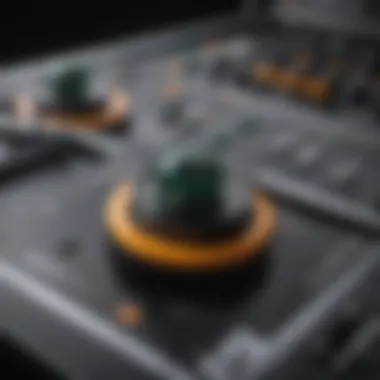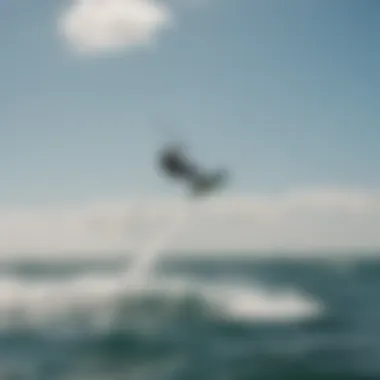Understanding the Liquid Force Mission Control Bar


Intro
In the fast-paced realm of kiteboarding, where every component of your gear influences performance and enjoyment, the Liquid Force Mission Control Bar stands out as a crucial element. With its innovative design and thoughtful engineering, this control bar shapes how enthusiasts interact with the kite, translating subtle inputs to dynamic responses in the air and water.
As kiteboarding becomes increasingly popular, understanding the intricacies of the equipment used is essential for both beginners and seasoned riders. The Mission Control Bar is not just a control device; it's a gateway to mastering the sport. With the right insights, kiteboarders can enhance their experience, pursuing thrilling maneuvers while maintaining safety and control.
This article intends to shed light on the Mission Control Bar, exploring its design philosophy, features, maintenance, and user experiences. By doing so, it aims to empower kiteboarders to make informed choices and understand the significance of this essential piece of gear.
Gear Insights
Latest Gear Reviews
In the kiteboarding community, reviews shape buying decisions. The Liquid Force Mission Control Bar has received applause for its robust build quality and intuitive features that cater to various skill levels. Some standout attributes include its unique below-the-bar trim adjustment and soft touch handle glide, designed to heighten the rider's comfort. Enthusiasts have lauded its ability to provide excellent feedback during high-speed maneuvers and shore landings. Community forums, such as those found on Reddit, often highlight rider experiences, making it easier to make an educated choice before purchasing.
Essential Gear for Beginners
For novice kiteboarders, a well-rounded setup can make all the difference. Besides the Mission Control Bar, essential gear includes a sturdy kite, a reliable harness, and a suitably sized board.
- Kite: Selecting a kite with a suitable size for wind conditions is key for beginners. A common recommendation is a mid-sized kite around 10-12m, which balances power and control.
- Harness: A comfortable and supportive harness prevents fatigue; choices typically range from seat to waist harnesses.
- Board: The board should offer stability and ease of use, with various options available for different conditions.
The discipline of kiteboarding relies on getting the right gear, and the Mission Control Bar supports that journey, ensuring smoother rides and greater enjoyment.
Techniques and Tips
Advanced Tricks and Techniques
For advanced kiteboarders, the Mission Control Bar significantly affects high-level maneuvers. Tricks such as handle passes and kite loops require precise control, which this bar facilitates with its responsive settings. The balance between the bar position and the kite can create exhilarating moments or potential mishaps, so mastering these techniques on familiar settings is wise before attempting in challenging conditions.
Safety Practices for Kiteboarders
No discussion about kiteboarding can overlook the importance of safety. The Liquid Force Mission Control Bar isn't just about performance; it's about keeping riders safe. Here are a few practices that are critical:
- Regular Gear Check: Inspect lines, knots, and the bar for wear and tear.
- Know Your Limits: Weather conditions can change rapidly; know when to head back.
- Use a Quick Release System: Ensure that your equipment features reliable quick release mechanisms for emergency situations.
In sum, while the Mission Control Bar plays a role in elevating kiteboarding performance, it also embodies the principles of risk management that characterize the sport.
"Kiteboarding is not just about skill; it’s a dance between man, gear, and nature."
Through this guide, kiteboarders can appreciate the intricacies of the Liquid Force Mission Control Bar, understand essential gear, techniques, and safety practices, and apply them to enhance their overall riding experience.
Prelude to Kiteboarding Equipment
Kiteboarding, a sport that beautifully dances on the boundary between thrill and skill, relies heavily on specialized equipment. Among these pieces, control bars play a pivotal role, often determining not just the effectiveness of kite maneuvers, but also the overall safety of the rider. Understanding the intricacies of kiteboarding apparatus is essential for both beginners and seasoned adventurers as it establishes a solid foundation for their riding experience.
Importance of Control Bars
Control bars serve as the primary interface between the kiteboarder and their kite. Without a well-crafted control bar, the thrill of catching wind and soaring above water can swiftly turn into a precarious situation. Here are some vital points to consider about control bars:
- Steering and Control: Steering a kite depends significantly on the control bar. A rider’s input on the bar translates directly into kite movement. Hence, the design and feel of the bar can drastically impact responsiveness and precision.
- Comfort During Use: The ergonomics of a control bar can either enhance or detract from a rider's experience. Features like grip texture, width, and adjustable height contribute to a comfortable setup, reducing fatigue during long sessions.
- Safety Mechanisms: Many modern bars incorporate safety features such as quick release systems, which can be lifesavers in emergency scenarios. Therefore, choosing a control bar with robust safety components is crucial for any rider, especially beginners.
Overview of Liquid Force Brand
Liquid Force has carved out a substantial niche in the kiteboarding world since its inception. Known for their commitment to innovation and quality, they have established a reputation for producing equipment that enhances performance while focusing on user satisfaction.
Liquid Force’s Mission Control Bar embodies this ethos, integrating advanced technology and rider feedback into its design. Here are some noteworthy aspects of the brand:
- Heritage and Experience: Founded in 1995, Liquid Force has decades of experience, which is evident in the quality of their products.
- Commitment to User-Centric Design: Liquid Force prioritizes rider input in their development process. This focus on real-world feedback ensures that each new product meets the actual needs of its users.
- Diverse Product Range: The brand does not limit itself to control bars. They also offer a broad selection of kites, boards, and other accessories, making them a one-stop shop for kiteboarding enthusiasts.
With this backdrop, diving deeper into the specifics of the Liquid Force Mission Control Bar allows for a much broader understanding of its relevance and capabilities in kiteboarding.
The Liquid Force Mission Control Bar Unpacked
When diving into the realm of kiteboarding, one cannot overlook the role of the control bar. The Liquid Force Mission Control Bar, specifically, stands as a cornerstone of this equipment—integral for both beginners and seasoned veterans. This section will examine the design features and functionality that set the Mission Control Bar apart, making it an essential piece of gear.
Design Features
Materials Used
The materials utilized in the construction of the Liquid Force Mission Control Bar are key to its performance and durability. Typically crafted from lightweight yet sturdy materials like aluminum and high-grade plastics, the choice of material is deliberate. This ensures that the bar remains responsive while withstanding the rigors of kiteboarding. Durability is paramount; therefore, these materials resist wear and tear over time, allowing kiteboarders to focus on their ride without the nagging worry of gear failure. However, while light materials are a benefit, they can sometimes lack the robustness expected in harsher conditions, so knowing the limits is crucial.
Shape and Size
The shape and size of the Mission Control Bar play a fundamental role in its usability. Designed with an ergonomic grip, the bar not only enhances comfort but also provides better control. Its dimensions are tailored to fit a range of hand sizes, ensuring that all riders can maintain a secure hold during their sessions. A notable feature is that the width can sometimes vary, allowing riders to select a bar size that aligns with their specific kite model and personal preferences. The advantage lies in the customizable feel it grants, but a larger size may unwittingly lead to fatigue over extended periods, something that riders must consider.


Aesthetic Aspects
Aesthetics in the design of the Mission Control Bar shouldn't be underestimated either. These bars come in a variety of vibrant colors and patterns, appealing to those who take pride in their gear. It might feel superficial, but the attractive looks can build confidence on the water, letting riders feel good about their equipment while they ride. The visuals offer inspiring design, yet they must also withstand sun damage, so it’s important not to overlook this aspect when choosing the right bar.
Functionality and Usability
Bar Pressure
Bar pressure refers to how much effort is needed to steer the kite, which can significantly influence the riding experience. The Liquid Force Mission Control Bar strikes a balance by ensuring an optimal level of bar pressure—not too heavy, yet not so light that it feels imprecise. This fine-tuning of pressure allows adjustments according to wind conditions and personal preferences, making it versatile across various environments. However, if the pressure settings are wrongly dialed, it could lead to an experience that feels either overly strenuous or disappointingly lackluster.
Shedding Water
A critical factor in performance is how well the bar sheds water. The Mission Control Bar incorporates features such as drainage holes or special texturing to facilitate quick water release when it gets splashed. This means less weight on the bar and a faster return to optimal handling after getting soaked. Quick water shedding complements the overall functionality by keeping alignments precise. If this aspect fails, riders might face slippage, resulting in a less enjoyable session.
Line Management
Proper line management is crucial for seamless operation while riding. The line management system on the Liquid Force Mission Control Bar promotes tangle-free experience. It uses cleats and relays designed to organize and handle lines effectively. This organized setup prevents snags, which can be a headache during any kiteboarding session. However, lines can also become tangled if not properly managed, and if the rider is not attentive, it could lead to awkward situations.
Think of having a well-organized workshop vs. a messy one; it's much easier to find what you need and work efficiently when everything has its place.
Overall, the design features and functionality of the Liquid Force Mission Control Bar seamlessly integrate to create a supportive experience for kiteboarders. They reinforce the bar's importance, enhancing the performance and enjoyment that comes with the sport.
Integration with Kites
When it comes to kiteboarding, having the right control bar is only half the battle. It’s like having a key without a lock; the connection between the Liquid Force Mission Control Bar and the various kites makes all the difference in performance and enjoyment. If you want to maximize your experience on the water, understanding how the control bar works with different kite models is essential.
Compatibility with Different Kite Models
The Liquid Force Mission Control Bar is designed with compatibility in mind. This means it does not only cater to one specific type of kite. If you own a variety of kites, this feature stands out. The bar pairs seamlessly with models across their kite range; being able to switch between can greatly enhance your session depending on wind conditions and personal skill level.
"Finding the right fit is as crucial as the kite itself. It’s a synergy that can really uplift your ride."
Riders appreciate the freedom that this compatibility affords. Whether you own a Liquid Force kite or another brand, understanding or trial fitting might provide the versatility you requires.
Adjustability and Customization
Further enhancing user experience is the adjustability aspect of the Mission Control Bar. It’s not just about having a bar that fits; it’s about how it fits you.
Length Adjustments
Length adjustments offer a unique advantage, especially when switching between kites or when conditions change drastically. With varying lengths, riders can personalize their grip and the overall feel of the kite in the air. This feature stands out for its key characteristic—a simple yet effective mechanism that can be tailored nearly on-the-fly.
The ability to fine-tune the length has become a favored choice among kiteboarders. This customization allows users to find that sweet spot where they feel in total control, leading to an enhanced feeling of confidence, which can directly impact performance.
Line Length Options
Another important topic under customization is line length options. With the Liquid Force Mission Control Bar, users can often choose between multiple line lengths according to the kite’s specifications. This flexibility is essential for various riding styles.
Unearthing the right line length can seriously impact handling and responsiveness during a session. An interesting aspect of choosing the right line length is the potential for greater handling capabilities. Shorter lines deliver snappier responses, while longer ones can provide a more stable ride in choppy conditions. Riders need to weigh the advantages and disadvantages and consider what aligns best with their goals.
This extensive familiarization with the integration of the Liquid Force Mission Control Bar truly elevates a kiteboarder's experience. Whether you’re a beginner still getting the hang of things or an advanced rider tweaking your setup, understanding these integrations allows for a more refined approach to kiteboarding.
Performance Analysis
Performance analysis of the Liquid Force Mission Control Bar is essential to understand how effectively it enhances the kiteboarding experience. This section delves into various feedbacks from different user levels, combined with real-world testing scenarios. Together, these investigations inform potential buyers and users about the control bar’s overall performance in diverse conditions.
Rider Feedback
Beginner Experiences
Beginner experiences with the Mission Control Bar often center around ease of use and user-friendliness. Many first-timers comment on how the control bar simplifies the learning process, providing a satisfying connection with the kite. A key characteristic that stands out is the intuitive layout of the bar and lines. These features reduce confusion, making it a popular choice for novices.
One unique feature is the adjustable length of the bar. New kiteboarders appreciate this adaptability, as it allows them to find a comfortable grip that suits their style and control level. While some may argue that beginners might prefer a simpler design, the versatility of this bar enables them to grow as riders without needing an immediate upgrade. Moreover, the increase in confidence stemming from better control is undeniably advantageous.
Advanced User Perspectives
Advanced users of the Liquid Force Mission Control Bar provide insights based on their extensive time on the water. They often highlight performance aspects such as precise handling and responsiveness, which are vital for more aggressive riding styles. This bar’s ability to fine-tune kite input is a characteristic that seasoned riders prize.
A specific aspect that stands out for advanced users is the bar pressure feedback. Many find it necessary for improving their skills in tricky conditions and executing advanced moves. However, some might argue that the sensitivity can make it overwhelming during gusty winds. Ultimately, flexibility and familiarization with the bar dynamics help riders make the most of its features.
Real-World Performance Tests
Wind Conditions


When examining the performance of the Mission Control Bar under various wind conditions, its capabilities emerge as crucial. Kiteboarders frequently emphasize the responsiveness of the bar in both light and strong winds. The feedback consistently aligns with its intention to facilitate a better riding experience.
In light winds, the bar's design allows for minimal input while still providing enough feel for control and stability. In contrast, in high winds, the pressure management becomes an essential focus, as riders experience the quick reflexes needed to maintain control. The ease with which users adapt in diverse wind types only strengthens its position as a go-to control bar for varying conditions.
Water Types
The type of water can significantly affect how the Mission Control Bar performs, too. Whether in flat water, choppy seas, or even waves, users' feedback reveals different experiences. In flat water, riders generally testify that the bar offers direct, immediate communication with the kite, enhancing their ability to land tricks and maintain speed.
On the other hand, in choppy or wave-filled settings, kiteboarders suggest that the bar handles turbulent conditions quite delicately, with adjustments that might be necessary. The added stability it provides stands out, but rapid movements and shifts can yield mixed reviews. The control bar stands up under scrutiny, but familiarity with the conditions remains paramount.
"A kiteboarder's choice of control bar can influence their riding significantly; understanding your environment lets you maximize the potential of your equipment."
The insights gathered from both rider experiences and environmental challenges articulate a well-rounded picture of this control bar’s performance. As such, it positions itself effectively within the broad kiteboarding landscape, appealing to various riders' needs.
Safety Considerations
Safety might not be the first thing on a kiteboarder's mind when they hit the water, but it absolutely should be. A good grasp of safety considerations not only enhances your enjoyment but also significantly reduces the risk of accidents. The Liquid Force Mission Control Bar, pivotal for maneuvering with precision, comes equipped with various safety features that are essential for every rider—from the novice who is just getting their footing to the seasoned professional performing jaw-dropping tricks. Understanding these elements is crucial in ensuring a safe and enjoyable kiteboarding experience.
Safety Features of the Mission Control Bar
Quick Release Mechanism
The Quick Release Mechanism is one of the standout elements in the safety arsenal of the Mission Control Bar. It's designed with the primary goal of enabling kiteboarders to detach from the sail with a single swift motion. This feature serves as a lifesaver during unexpected situations, such as strong gusts or when a rider finds themselves tangled or in danger. It's straightforward to operate, which is undoubtedly a beneficial trait, especially for those still learning the ropes.
A key characteristic of this mechanism is its reliability; it shines in challenging conditions, offering riders some peace of mind. However, it is vital to practice using it outside of actual sessions as familiarity can ensure a quick response when needed. Some users have noted a slight delay in action if the mechanism hasn’t been regularly exercised or maintained, but it's a minor trade-off against the safety it provides when push comes to shove.
Safety Line Configuration
Safety Line Configuration plays another significant role in kiteboarding safety. This system effectively manages the distribution of force, ensuring that when pressure is applied, like in a sudden crash or hard pull, the forces are spread out evenly. It reduces the risk of equipment failure, which can have serious consequences while out on the water.
An essential advantage of this configuration is its simplified layout, which makes it user-friendly for riders at any skill level. The design minimizes the chance of line tangles and other complications that may arise during high-stakes maneuvers. On the downside, some riders have reported that too much simplicity can lead to decreased personal adjustment options—however, the trade-off comes down heavily in favor of safety.
Best Practices for Safe Use
Pre-Session Checks
Engaging in thorough Pre-Session Checks is a practice all kiteboarders should adopt without fail. These checks help catch potential issues before they spiral into bigger problems out on the water. Riders should inspect their gear, paying close attention to the control bar, lines, and kite for any wear or tear that might have gone unnoticed. Equally crucial is ensuring that the Quick Release Mechanism operates smoothly.
The main advantage here is that a few moments spent examining your gear can significantly reduce your chances of a mishap. Skipping this simple task can often lead to equipment failure mid-ride, resulting in distressing and potentially dangerous situations. An additional unique feature worth mentioning is the rider's own physical readiness—being aware of personal conditioning and recent injuries contributes to a safer overall experience.
Emergency Protocols
Emergency Protocols are another necessary item on the kiteboarder's checklist. We, as riders, should know what steps to take when things go awry. Whether it's getting caught in extremely high winds or experiencing gear failure, quick and decisive action is required. Being equipped with the right knowledge can ensure calm in a stressful situation, preventing panic.
Outlining these protocols before entering the water is a smart move. Communication signals with crew members or friends on the beach can make recovery or rescue easier. Moreover, engaging in workshops or training sessions that focus on emergency techniques can familiarize riders with various potential scenarios, enabling better performance under stress. The downside is that such training might require commitment in terms of time and effort, but these investments lead to critical skills that can't be overlooked in our thrilling pursuit.
Preparation is key; being prepared can mean the difference between a close call and a successful ride.
Maintenance and Care
Proper maintenance and care of the Liquid Force Mission Control Bar is not just a suggestion; it's a necessity. Maintaining this crucial piece of equipment extends its lifespan, ensures safety, and ultimately enhances your kiteboarding experience. Kiteboarding can expose gear to harsh environments – water, salt, sand, and sun – all of which take their toll over time. By following diligent maintenance protocols, riders can avoid costly replacements and enjoy smoother sessions on the water.
Routine Maintenance Tips
Keeping your Mission Control Bar in tip-top shape involves regular attention. Here are some essential maintenance tips:
- Rinse After Use: Saltwater and sand can quickly wear down components. Always rinse your control bar with fresh water after every session, ensuring that it’s free from residue.
- Check the Lines: Regularly inspect the lines for frays or unraveling. Look for kinks or knots that might compromise the bar's performance.
- Examine Connections: The connection points, including the quick release mechanism, should be checked for any signs of wear. Replace parts that show damage to maintain safety.
- Bar Pressure: Adjust the bar pressure according to your comfort level. Too much pressure can lead to hand fatigue, while too little can result in decreased control.
Performing these routine checks and cleanings may feel tedious but will pay off when you’re out on the water, giving you peace of mind about your gear’s reliability.
Longevity and Storage
Just as vital as maintenance is understanding how to store your equipment correctly. Proper storage is a game changer for increasing the life of your gear. Here’s how to ensure that your Mission Control Bar stays in prime condition when not in use:
- Keep It Dry: Always store your bar in a cool, dry place. Moisture can lead to mildew or corrosion, particularly on the lines and metal components.
- Avoid Direct Sunlight: Prolonged exposure to sunlight can degrade materials over time. Store it in a shaded area or place it inside a protective bag.
- Use a Protective Cover: If your bar comes with a cover, use it. It serves as a barrier against scratches and dust.
- Store Flat: Lay your control bar flat rather than hanging it. This prevents unnecessary stress on the lines and maintains their integrity.
By practicing these storage principles, adventurers can keep their control bar in mint condition, ensuring its readiness for the next ride.
"Taking care of your kiteboarding gear isn't just about preserving your investment; it's about enhancing your overall experience on the water."
In the end, the proper maintenance and care of the Liquid Force Mission Control Bar are paramount. By implementing a routine of checks, proper cleaning, and sensible storage, kiteboarders can extend their equipment’s lifespan and ultimately increase their enjoyment of the sport.


Comparative Analysis
Comparative analysis plays a crucial role in evaluating the Liquid Force Mission Control Bar within the larger landscape of kiteboarding equipment. By contrasting it with similar control bars available in the market, we delve into its strengths, weaknesses, and unique selling propositions. This exploration not only aids buyers in making informed choices but also highlights where Liquid Force excels and where it might fall short amidst the competition.
Comparison with Other Control Bars
Market Competitors
The mission control bar faces stiff competition from brands like Cabrinha and Naish, each boasting their own set of features that cater to a range of user preferences and technical requirements. These market competitors often offer superior grip through textured materials or have unique line management systems designed to reduce tangling, which is invaluable during high-pressure sessions on the water.
A defining characteristic of these alternatives is their adaptability to different kite designs; for instance, Cabrinha’s bars often include adjustable sliders, making them appealing for a versatile user experience. While Liquid Force’s Mission Control Bar may not match these bars in every feature, its strength lies in its exceptional durability and straightforward usability, making it a solid choice for both beginners and seasoned riders.
One unique feature of these competitors could involve their ability to offer additional customization options, such as a wide range of color choices, which can enhance personal style on the water. However, this aspect can sometimes complicate the selection for newer kiteboarders who prefer simplicity over a myriad of choices.
Unique Selling Points
When analyzing unique selling points, the Mission Control Bar stands out primarily through its intuitive design philosophy, focusing heavily on rider comfort and ease of use. One notable feature is the one-pull trim system, which allows for quick adjustments in challenging wind conditions. This element is highly beneficial in ensuring that riders can swiftly modify their setup without disrupting their momentum.
Additionally, the integrated safety features—like the industry-standard quick-release mechanism—provide peace of mind, especially for those newer to the sport. Despite this, some riders may feel that the bar's weight could be an issue in extreme conditions compared to lighter alternative options.
User Preferences and Trends
Emerging Preferences
Kiteboarding trends suggest a shift towards lightweight, minimalist designs in equipment, including control bars. Emerging preferences reveal a growing desire among kiteboarders for gear that facilitates freedom of movement and reduces fatigue. Riders are gravitating towards options that not only perform well but also align with ethical manufacturing processes, showcasing an inclination towards sustainability.
In this context, the Liquid Force Mission Control Bar appeals to those who favor a balance of performance and eco-friendliness, but it occasionally trails behind competitors who have made more pronounced commitments to sustainable materials.
Legacy Choices
Some kiteboarders cling to legacy choices, opting for gear that has consistently performed well over the years. This trend highlights how established products often become entrenched in the kiteboarding culture, with users developing a deep sense of loyalty. The Mission Control Bar has its share of long-time users who appreciate its reliability and consistent performance under various conditions.
The key characteristic driving these legacy choices is often familiarity; many riders have invested time in mastering a specific bar's mechanics and prefer not to switch mid-stream. However, this can create a challenge for Liquid Force, as new users may overlook its offerings in favor of more widely recognized options.
"The true test often lies in how gear holds up in real-world scenarios, rather than just in the specifications presented on paper. Investing in equipment that has a proven track record builds confidence."
Overall, comparative analysis provides a comprehensive look at the Liquid Force Mission Control Bar, shedding light on both its strengths and areas where it may need to catch up. Understanding these dynamics helps kiteboarders make more informed decisions, ensuring that they choose equipment that aligns with their personal style and riding preferences.
The Future of Liquid Force Control Bars
As kiteboarding continues to evolve, so does the equipment that supports it. The Liquid Force Mission Control Bar is at the forefront of this advancement. Understanding the future of these control bars is pivotal for kiteboarders who want to stay ahead of the curve. The transitions in innovation and consumer expectations will shape the design and functionality of future control bars, reflecting not only technological improvements but also the evolving preferences of riders.
Innovations on the Horizon
Liquid Force's commitment to push boundaries means that innovations are always on the horizon. Some anticipated developments include:
- Smart Technology: Imagine being able to monitor your bar's performance in real-time. Some brands are exploring sensors that could provide feedback on bar tension and kite responsiveness, helping riders to adjust their techniques on-the-fly.
- Adjustable Sizes: Adaptive designs that allow riders to modify bar length based on their height or riding style could become mainstream, ensuring optimal control and comfort.
- Eco-Friendly Materials: As sustainability takes the forefront in many industries, kiteboarding gear may soon feature materials that are both lighter and environmentally friendly, appealing to a conscientious rider base.
"Innovation is not just about new products; it’s about understanding what the future rider needs and adapting to that evolution."
Consumer Expectations
Today’s kiteboarders are not just looking for a piece of equipment; they seek an experience that aligns with their specific needs and preferences. Hence, the future control bars must accommodate varied expectations:
- Customization: Riders desire products that can be tailored. Future control bars may offer modular components where users can add or remove parts based on their preferences.
- Durability and Performance: There’s an unyielding demand for gear that withstands the elements without sacrificing performance. The expectation is for bars that can endure harsh conditions, providing confidence to explorers hitting different water types.
- User-friendly Features: Simplified adjustments and intuitive usability are becoming increasingly critical. A control bar that is easy to set up and use can make or break a rider's day.
The future of Liquid Force control bars is not just about improving existing capabilities but about creating a more holistic and invigorating experience for the rider. The anticipated innovations and shifting consumer expectations highlight a dynamic landscape that both novice and seasoned kiteboarders should monitor closely.
Closure
The conclusion of this article serves as a vital recap, enfolding the myriad insights discussed about the Liquid Force Mission Control Bar. Understanding each element brought to light isn't merely an academic exercise; it's a practical necessity for anyone serious about kiteboarding.
Summarizing Key Insights
As we reflect on the discussion, several key points emerge prominently.
- Design Matters: The Mission Control Bar's design integrates both functionality and aesthetics, ensuring it not only performs well but also appeals visually to riders.
- Safety Comes First: Safety features like the quick release mechanism highlight the importance of risk management while kiteboarding, making it essential for both novices and experienced riders.
- User Experience is Crucial: Feedback from actual riders underscores the importance of usability, translating technical features into real-world applications.
- Market Positioning: The bar's comparatives reveal how it stands out amongst its peers, offering unique selling points that can be the deciding factor for potential buyers.
This comprehensive overview reinforces the need for riders to scrutinize the equipment they invest in, ensuring it aligns with their riding style and capability.
Final Thoughts on the Mission Control Bar
To wrap things up, the Liquid Force Mission Control Bar is not just a tool but an extension of a rider's intent and skills. It encapsulates the ethos of kiteboarding—freedom, control, and adventure. For travelers yearning for a connection with the ocean or instructors molding the next generation of enthusiasts, this control bar stands as a reliable companion.
As kiteboarding continues to evolve, the expectations of users will invariably rise, pushing manufacturers to innovate and offer even more compelling options. In this dynamic landscape, the Liquid Force Mission Control Bar exemplifies how equipment can significantly enhance the overall experience, making every session on the water not just possible but truly exhilaratting.
"In kiteboarding, your gear is your lifeline. Trust in what you have means trusting your skills." - Unknown
It's clear that a deeper understanding of such essential pieces of equipment can enhance not only performance but the safety and enjoyment of the sport itself.















